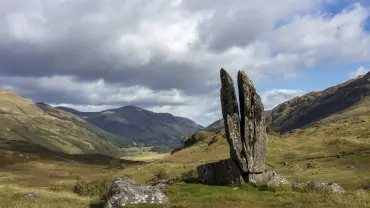In the dense woods of the Pine Barrens of New Jersey, whispers of a grotesque winged monster have echoed through the centuries and become a folk legend.
From chilling campfire tales to sightings reported in broad daylight, the mythology surrounding the Jersey Devil story weaves together a rich tapestry of history, societal anxieties, and the ever-blurring line between fact and fiction.
Although many legends detail its birth, what’s truly captivating is how this creature has morphed, evolved, and persisted in the American consciousness. Will the truth of the Jersey Devil, explained here, ever come to light?
The Home of the Jersey Devil Story
To answer the question ‘what is the Jersey Devil’, we must start with an appreciation for and understanding of the intricacies of its homeland.
The birthplace of the Jersey Devil is a vast, mysterious region known as the Pine Barrens, stretching across 1,700 square miles of southeastern New Jersey. This expansive area, more than just a wilderness, is an immense aquifer packed with thickets of white cedar whose roots dye the waterways with a tannen-infused red hue.
While the pine barrens appear desolate, it surprisingly nurtures twenty-seven orchid species. The labyrinthine roads can trace their lineage back to ancient paths, historic stagecoach routes, and colonial settlements. Whether paved or sandy, these roads bear intriguing names like Hog Wallow, Double Trouble, and Sooy Place, echoing the early days of New Jersey’s colonisation. But do these roads tell us the truth of the Jersey Devil?
The Origins of the Legend
Is the Jersey Devil explained easily? As with all folklore and legends, with each retelling, stories are exaggerated and added to and over the course of almost three centuries, it’s likely the current versions of the story bear no resemblance to the original. But the most popular incarnation of the Jersey Devil story starts with Mother Leeds.
In a small southern New Jersey town, possibly Estellville or Leeds Point, a local woman known as Mother Leeds was pregnant with her thirteenth child. On a stormy night in 1735, it’s said she was horrified at the thought of the number thirteen and cried out ‘let this one be the devil’. As the midwives and her family gathered round the bed, a beautiful baby boy was born.
Yet within minutes, it seems her wish came true. The legend tells that the boy transformed into a winged monster, savaging those in the room and flying up and out through the chimney. The creature that escaped that night has been terrorising the Pine Barrens ever since. The Jersey Devil story was born.
What Does the Jersey Devil Look Like?
Each version of the story seems to produce a more terrifying rendering of the Jersey Devil. An elongated part-man, part animal body with the horned head of a goat or a horse, leathery bat-like wings, cloven hoofs on the end of short front legs, a pointed tail and eyes that glowed devil-red. It was also said to have possessed a scream so blood-curdling it was reported to have reduced the toughest of men to quivering wrecks for the rest of their lives.

Read More About: Mysteries
What Happened to the Lost Expedition of Lapérouse?
In the years that followed, mysterious tracks, boiling streams, damaged chicken coops, destroyed crops and dead farm animals have all been attributed to the Jersey Devil. In January 1909, numerous sightings were reported in the towns of Haddon Heights, Collingswood and Camden in the Delaware Valley, miles from the heart of the New Jersey Pine Barrens. At one stage, a reward of $10,000 was put up for the capture of the Jersey Devil, either dead or alive. The money remained unclaimed.
What is the Jersey Devil - Fact or Fiction?
To many, the Jersey Devil story is an oft-embellished work of fiction. Yet to others, belief is very real. Decorated US Navy Commodore Stephen Decatur is reported to have seen a flying creature that he couldn’t identify. Even Joseph Bonaparte, the brother of Napoleon is said to have seen it whilst on his New Jersey estate around 1820.
Other sightings, including from a group of local residents who saw an unknown animal ‘with red eyes’ in July 1937, and fourteen years later by a group of teenage boys who saw ‘a monster’. In 1960, unidentified tracks near Mays Landing were spotted and said to be from the Jersey Devil.
Must Read
Even today, people driving down the Garden State Parkway or the Atlantic City Expressway have reported unusual sightings or strange happenings. Some say it appears every seven years. Others say its presence foreshadowed disaster or became a premonition of war.
What of the truth of the Jersey Devil? Perhaps there isn’t a truth. One rumour suggested it was a pterodactyl or a paleosaurus that had somehow survived millions of years in New Jersey’s limestone caves. Another said it could have been a particularly aggressive ostrich or sandhill crane.
Beyond the Barrens - The Legend of the Jersey Devil

Illustration of the Mythological Jersey Devil. (Credit: Bettmann / Contributor via Getty Images)
As we attempt to answer the question ‘what is the Jersey Devil’, tales have passed from one generation to the next. They’ve transformed from scary stories around the campfire to an integral part of American folklore. The Pine Barrens, with its dense forests and unique landscapes, has served as the perfect backdrop for the legend to flourish.
But beyond the spine-tingling encounters and mysterious sightings, the Jersey Devil story offers a deeper reflection on society’s need for myths and the manner in which they evolve over time. It’s a testament to how tales can intertwine with history, geography, and culture, creating legacies that endure.












